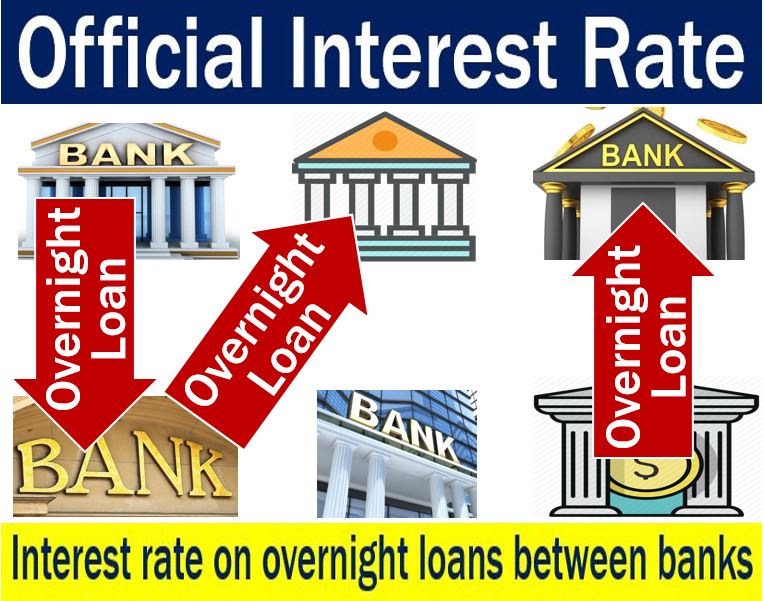The official interest rate is the rate that the central bank and other banks charge for overnight loans. In other words, the rate banks charge each other for one-day maturity loans. In the US and most other countries, the banks use the money they deposited in their central bank for these loans.
The Bank of England, the UK’s central bank, says these are loans with a one-day maturity rate. Countries may, however, refer to the official interest rate with different terms.
For example, in the UK, people call it the official bank rate. Australians and New Zealanders call it the official cash rate.
Official interest rate – United States
In the US, the federal funds rate is the rate that banks charge one another for overnight lending. Overnight lending means the same as loans with a one-day maturity.
The markets set this US base rate, rather than the Federal Reserve System. The Federal Reserve System (Fed) is the US central bank.
By adding or withdrawing funds from the money supply, the Fed hopes it can achieve its aim. The central bank aims to bring the effective federal funds rate into line with the interest rate it seeks.
When the Fed’s monetary policy changes the base rate, it affects the interest rates on many financial products. For example, it affects the interest rates on savings, loans, and mortgages.

Official interest rates – euro area
The European Central Bank (ECB) uses the plural term ‘official interest rates.’
The ECB’s Governing Council says it sets out its key official interest rates in the following areas:
– MRO interest rate. MRO stands for main refinancing operations. This interest rate provides the bulk of the banking system’s liquidity.
– Deposit facility interest rate. Financial institutions use this facility to make overnight deposits with the Eurosystem.
– The interest rate on the marginal lending facility. This facility offers overnight credit to European banks from the Eurosystem.
Video – What is the Official Interest Rate?
Official lending rate – in a nutshell
Put simply; the official interest rate can mean different things to different people.
Alternatively, we could say it means the same thing to different people, who express it in a variety of ways.
The official interest rate, however, in most cases, refers to the overnight lending rate financial institutions use. Specifically, the rates they use when lending to each other.
Impact on the Wider Economy
The repercussions of fluctuations in the official interest rate are vast and influence the broader economy.
When the central bank alters the official interest rate, it isn’t just the financial institutions that feel the change. Consumers and businesses experience shifts in their borrowing and spending capacities, directly impacting their financial decisions.
A hike in the rate might deter borrowing and encourage saving, while a decrease could stimulate spending and investment. These dynamics, in turn, affect economic growth, employment rates, and the overall health of the economy.
According to Venture Line, the official interest rate is:
“The rate of interest charged by the government or traders within the money market, e.g., federal funds rate and bank repurchase agreement (repo rate).”
